St. Augustine
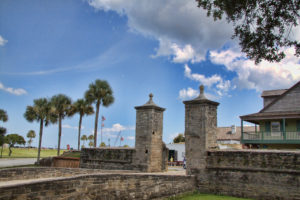 (Spanish: San Agustín) is a city in the southeastern United States, on the Atlantic coast in northeastern Florida. It is the oldest continuously occupied European-established settlement within the borders of the contiguous United States.
(Spanish: San Agustín) is a city in the southeastern United States, on the Atlantic coast in northeastern Florida. It is the oldest continuously occupied European-established settlement within the borders of the contiguous United States.
The county seat of St. Johns County, it is part of Florida’s First Coast region and the Jacksonville metropolitan area. According to the 2010 census, the city population was 12,975. The United States Census Bureau’s 2013 estimate of the city’s population was 13,679, while the urban area had a population of 69,173 in 2012.
Saint Augustine was founded 451 years ago on September 8, 1565, by Spanish admiral Pedro Menéndez de Avilés, Florida’s first governor. He named the settlement “San Agustín,” as his ships bearing settlers, troops, and supplies from Spain had first sighted land in Florida eleven days earlier on August 28, the feast day of St. Augustine. The city served as the capital of Spanish Florida for over 200 years, and became the capital of British East Florida when the territory briefly changed hands between Spain and Britain.
Spain ceded Florida to the United States in 1819, and when the treaty was ratified in 1821, St. Augustine was designated the capital of the Florida Territory until Tallahassee was made the capital in 1824. Since the late 19th century, St. Augustine’s distinct historical character has made the city a major tourist attraction, and it is also the headquarters for the Florida National Guard.
Founding by Pedro Menéndez de Avilés
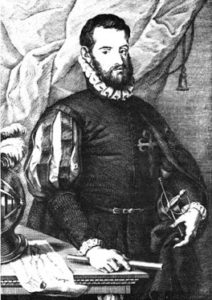 Founded in 1565 by the Spanish conquistador, Pedro Menéndez de Avilés, St. Augustine is the oldest continuously occupied settlement of European origin in the United States. In 1562, a group of Huguenots led by Jean Ribault arrived in Spanish Florida to establish a colony in the territory claimed by Spain. They explored the mouth of the St. Johns River, calling it la Rivière de Mai (the River May), then sailed northward and established a settlement called Charlesfort at Port Royal Sound in present-day South Carolina. Spain learned of this French expedition through its spies at ports on the Atlantic coast of France. The Huguenot nobleman René de Laudonnière, who had participated in the expedition, returned to Florida in 1564 with three ships and 300 Huguenot colonists. He arrived at the mouth of the River May on June 22, 1564, sailed up it a few miles, and founded Fort Caroline.
Founded in 1565 by the Spanish conquistador, Pedro Menéndez de Avilés, St. Augustine is the oldest continuously occupied settlement of European origin in the United States. In 1562, a group of Huguenots led by Jean Ribault arrived in Spanish Florida to establish a colony in the territory claimed by Spain. They explored the mouth of the St. Johns River, calling it la Rivière de Mai (the River May), then sailed northward and established a settlement called Charlesfort at Port Royal Sound in present-day South Carolina. Spain learned of this French expedition through its spies at ports on the Atlantic coast of France. The Huguenot nobleman René de Laudonnière, who had participated in the expedition, returned to Florida in 1564 with three ships and 300 Huguenot colonists. He arrived at the mouth of the River May on June 22, 1564, sailed up it a few miles, and founded Fort Caroline.
Desiring to protect its claimed territories in North America against such incursions, the Spanish Crown issued an asiento to Menéndez, signed by King Philip II on March 20, 1565, granting him expansive trade privileges, the power to distribute lands, licenses to sell 500 slaves, as well as various titles, including that of adelantado of Florida. This contract directed Menéndez to sail for La Florida, reconnoitre it from the Florida Keys to present-day Canada, and report on its coastal features, with a view to establishing a permanent colony for the defense of the Spanish treasure fleet. He was ordered as well to drive away any intruders who were not subjects of the Spanish crown.
On July 28, Menéndez set sail from Cádiz with a fleet led by his 600-ton flagship, the San Pelayo, accompanied by several smaller ships, and carrying over 1,000 sailors, soldiers, and settlers. On the feast day of St. Augustine, August 28, the fleet sighted land and anchored off the north inlet of the tidal channel the French called the River of Dolphins. Menéndez then sailed north and confronted Ribault’s fleet outside the bar of the River May in a brief skirmish. On September 6, he returned to the site of his first landfall, naming it after the Catholic saint, disembarked his troops, and quickly constructed fortifications to protect his people and supplies.
Menéndez then marched his soldiers overland for a surprise attack on Fort Caroline, where they killed almost everyone in the fort except for the women and children. Jean Ribault had already put out to sea with his ships for an assault on St. Augustine, but was surprised by a storm that wrecked his ships further south. Informed by his Indian allies that the survivors were walking northward on the coast, Menéndez began to search for the Frenchmen, who had made it as far as the banks of the river’s south entrance. There they were confronted by the Spaniard and his men on the opposite side. After several parleys with the Spanish, Jean Ribault and the Frenchmen with him (between 150–350, sources differ) surrendered; almost all of them were executed in the dunes near the inlet, thereafter called Matanzas (Spanish for “slaughters”).
In May 1566, as relations with the neighboring Timucua Indians deteriorated, Menéndez moved the Spanish settlement to a more defensible position on the north end of the barrier island between the mainland and the sea, and built a wooden fort there. In 1572, the settlement was relocated to the mainland, in the area just south of the future town plaza. Confident that he had fulfilled the primary conditions of his contract with the King, including the building of forts along the coast of La Florida, Menéndez returned to Spain in 1567. After several more transatlantic crossings, Menéndez fell ill and died on September 17, 1574.
Invasions by pirates and enemies of Spain
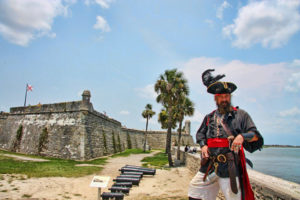 Succeeding governors of the province maintained a peaceful coexistence with the local Native Americans, allowing the isolated outpost of St. Augustine some stability for a few years. On May 28 and 29, 1586, soon after the Anglo-Spanish War began between England and Spain, the English privateer Sir Francis Drake sacked and burned St. Augustine. The approach of his large fleet obliged Governor Pedro Menéndez Márquez and the townspeople to flee for their safety. When the English got ashore, they seized some artillery pieces and a royal strongbox containing gold ducats, the garrison payroll. The killing of their sergeant major by the Spanish rearguard caused Drake to order the town burnt.
Succeeding governors of the province maintained a peaceful coexistence with the local Native Americans, allowing the isolated outpost of St. Augustine some stability for a few years. On May 28 and 29, 1586, soon after the Anglo-Spanish War began between England and Spain, the English privateer Sir Francis Drake sacked and burned St. Augustine. The approach of his large fleet obliged Governor Pedro Menéndez Márquez and the townspeople to flee for their safety. When the English got ashore, they seized some artillery pieces and a royal strongbox containing gold ducats, the garrison payroll. The killing of their sergeant major by the Spanish rearguard caused Drake to order the town burnt.
In 1609 and 1611, expeditions were sent out from St. Augustine against the English settlement at Jamestown, Virginia. In the second half of the 17th century, unsettled groups of Indians, forced southward by the expanding English colony in Carolina, made raids into Florida and killed the Franciscan priests who served at the Catholic missions. Requests by successive governors of the province to strengthen the presidio’s garrison and fortifications were ignored by the Crown. The charter of 1663 for the new Province of Carolina, issued by King Charles II of England, was revised in 1665, claiming lands as far southward as 29 degrees north latitude, about 65 miles south of the existing Spanish settlement at St. Augustine.
The English buccaneer Robert Searle then sacked St. Augustine in 1668, killing sixty people and pillaging government buildings, churches and houses, after which his pirates ransomed off some of their hostages and sold others into slavery. This raid and the establishment of the English settlement at Charles Town spurred the Spanish monarchy to finally acknowledge the threat represented by the new English colonies to the north and strengthen the city’s defenses. In 1669, Queen Regent Mariana ordered the Viceroy of New Spain to disburse funds for the construction of a permanent masonry fortress, which began in 1672. The Castillo de San Marcos was completed in 1695, not long before an attack by Governor Moore’s forces from Carolina in November, 1702. Failing to take the fort after a siege of 58 days, the British troops burned St. Augustine to the ground as they retreated. In 1740, the town was again besieged, this time by the governor of the British colony of Georgia, General James Oglethorpe, who was also unable to take the fort.
Loyalist haven under British rule
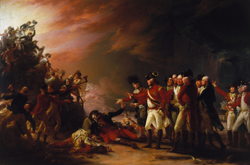 The Treaty of Paris (1763), signed after Great Britain’s victory over France and Spain during the Seven Years’ War, ceded Florida to Great Britain and consequently St. Augustine became a Loyalist haven during the American Revolutionary War. The second Treaty of Paris (1783), which recognized the independence of the former British colonies north of Florida, also ceded Florida back to Spain, and as a result many of the town’s Spanish citizens returned to St Augustine. Refugees from Dr. Andrew Turnbull’s troubled colony in New Smyrna had fled to St. Augustine in 1777, and made up the majority of the city’s population during British rule. This group was (and still is) referred to locally as “Minorcans”, even though it also included settlers from Corsica, Italy and the Greek islands as well.
The Treaty of Paris (1763), signed after Great Britain’s victory over France and Spain during the Seven Years’ War, ceded Florida to Great Britain and consequently St. Augustine became a Loyalist haven during the American Revolutionary War. The second Treaty of Paris (1783), which recognized the independence of the former British colonies north of Florida, also ceded Florida back to Spain, and as a result many of the town’s Spanish citizens returned to St Augustine. Refugees from Dr. Andrew Turnbull’s troubled colony in New Smyrna had fled to St. Augustine in 1777, and made up the majority of the city’s population during British rule. This group was (and still is) referred to locally as “Minorcans”, even though it also included settlers from Corsica, Italy and the Greek islands as well.
Second Spanish Period
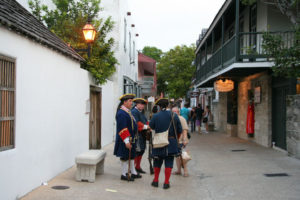 During the Second Spanish Period (1784-1821) of its rule in Florida, Spain was dealing with invasions of the Iberian peninsula by Napoleon’s armies in the Peninsular War, and struggled to maintain a tenuous hold on its colonies in the western hemisphere as revolution swept South America. The royal administration of Florida was neglected, as the province had long been regarded as an unprofitable backwater by the Crown. The United States, however, considered Florida vital to its political and military interests as it expanded its territory in North America, and maneuvered by sometimes clandestine means to acquire it. The Adams–Onís Treaty, negotiated in 1819 and concluded in 1821, ceded Florida and St. Augustine, still its capital at the time, to the United States.
During the Second Spanish Period (1784-1821) of its rule in Florida, Spain was dealing with invasions of the Iberian peninsula by Napoleon’s armies in the Peninsular War, and struggled to maintain a tenuous hold on its colonies in the western hemisphere as revolution swept South America. The royal administration of Florida was neglected, as the province had long been regarded as an unprofitable backwater by the Crown. The United States, however, considered Florida vital to its political and military interests as it expanded its territory in North America, and maneuvered by sometimes clandestine means to acquire it. The Adams–Onís Treaty, negotiated in 1819 and concluded in 1821, ceded Florida and St. Augustine, still its capital at the time, to the United States.
Territory of Florida
Florida remained an organized territory of the United States until 1845, when it was admitted into the Union as the State of Florida. The Territorial Period (1821-1845) was marked by protracted wars with the Creek Indian groups who occupied the peninsula, collectively known as “Seminoles”, during the Second Seminole War (1835-1842). The United States Army took command of the Castillo de San Marcos and renamed it Fort Marion after General Francis Marion, who fought in the American Revolutionary War.
Civil War
Florida joined the Confederacy after the Civil War began in 1861, and Confederate authorities remained in control of St. Augustine for fourteen months, even though it was barely defended, and in spite of the Union blockade of shipping off the coast. Union troops occupied St. Augustine in 1862 and controlled the city through the rest of the war. Its economy already devastated, many of the town’s citizens fled.
Henry Flagler and the railroad
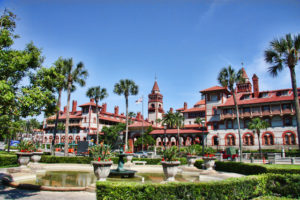 Henry Flagler, a co-founder with John D. Rockefeller of the Standard Oil Company, spent the winter of 1883 in St. Augustine and found the city charming, but considered its hotels and transportation systems inadequate. He had the idea to make St. Augustine a winter resort for wealthy Americans from the north, and to bring them south he bought several short line railroads and combined these in 1885 to form the Florida East Coast Railway. He built a railroad bridge over the St. Johns River in 1888, opening up the Atlantic coast of Florida to development.
Henry Flagler, a co-founder with John D. Rockefeller of the Standard Oil Company, spent the winter of 1883 in St. Augustine and found the city charming, but considered its hotels and transportation systems inadequate. He had the idea to make St. Augustine a winter resort for wealthy Americans from the north, and to bring them south he bought several short line railroads and combined these in 1885 to form the Florida East Coast Railway. He built a railroad bridge over the St. Johns River in 1888, opening up the Atlantic coast of Florida to development.
Flagler began construction in 1887 of two large ornate hotels, the 540-room Ponce de León Hotel and the Hotel Alcazar, and bought the Casa Monica Hotel the next year. His chosen architectural firm, Carrère and Hastings, radically altered the appearance of St. Augustine and gave it a skyline, beginning an architectural trend in the state characterized by the use of elements of the Moorish Revival style. With the opening of the Ponce in 1888, St. Augustine became the winter resort of American high society for a few years.
After Flagler’s Florida East Coast Railroad had been extended southward to Palm Beach and then Miami, the rich mostly abandoned St. Augustine in the early 20th century and began to customarily spend their winters in South Florida, where the climate was warmer and freezes were rare. St. Augustine nevertheless still attracted tourists, and eventually became a destination for families traveling in automobiles as new roads were built and Americans took to the road for annual summer vacations. The tourist industry soon became the dominant sector of the local economy. With the help of state and federal government monies, St. Augustine began a program in 1935 to preserve thirty-six surviving colonial buildings and reconstruct others that were gone.
Modern St. Augustine
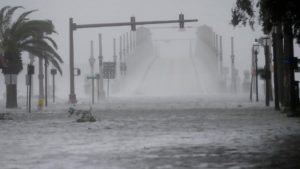 In 1965, St. Augustine celebrated the quadricentennial of its founding, and jointly with the State of Florida, inaugurated a program to restore part of the colonial city. When the State of Florida abolished the Historic St. Augustine Preservation Board in 1997, the City of St. Augustine assumed control of more than thirty-six buildings that had been reconstructed or restored to their historical appearance, as well as other historic properties including the Government House. In 2015, St. Augustine celebrated its 450th year of its founding with a visit from Felipe VI of Spain and Queen Letizia of Spain. On October 7, 2016 Hurricane Matthew caused widespread flooding in downtown St. Augustine
In 1965, St. Augustine celebrated the quadricentennial of its founding, and jointly with the State of Florida, inaugurated a program to restore part of the colonial city. When the State of Florida abolished the Historic St. Augustine Preservation Board in 1997, the City of St. Augustine assumed control of more than thirty-six buildings that had been reconstructed or restored to their historical appearance, as well as other historic properties including the Government House. In 2015, St. Augustine celebrated its 450th year of its founding with a visit from Felipe VI of Spain and Queen Letizia of Spain. On October 7, 2016 Hurricane Matthew caused widespread flooding in downtown St. Augustine
